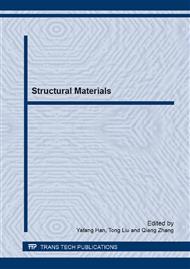p.1
p.7
p.12
p.17
p.23
p.28
p.34
p.41
Influence of Various Precipitate Phases on Tensile Properties of an Extruded Mg-Y-Nd Alloy
Abstract:
The high strength of Mg-Y-Nd alloy has been achieved primarily by precipitation hardening. Therefore, it is important to investigate the influence of various precipitate phases on the tensile properties of Mg-Y-Nd alloys. In this study, an extruded Mg-Y-Nd alloy was aged at various temperatures to examine the hardening behaviors. The results showed that the as-extruded alloy exhibited remarkable age hardening response at 210°C due to the precipitation of β’, and slight hardening response at 150°C and 280°C due to the precipitation of β’’ and β, respectively. Furthermore, different precipitates exerted different effects on the tensile properties. In comparison with the as-extruded alloy, the yield strength of the alloys aged at 210 °C and 150 °C was increased by 21 MPa and 8 MPa, respectively, whereas the yield strength of the alloy aged at 280°C was decreased by 30 MPa. The elongation of the alloy aged at 210°C and 150°C was also largely reduced by 3.4% and 2.9%, respectively, while the elongation of the alloy aged at 280°C was only slightly reduced (6.3%). Moreover, compared with the as-extruded alloy, the alloy aged at 210°C and 150°C exhibited lower hardening capacity and higher strain hardening rate at the initial stage, but the strain hardening rate decreased more quickly with the increasing stress. The alloy aged at 280°C exhibited similar strain hardening behavior with the as-extruded alloy. The results in this study provide guidelines for determining the heat treatment parameters for the Mg-Y-Nd alloys to improve their tensile properties.
Info:
Periodical:
Pages:
17-22
Citation:
Online since:
April 2014
Authors:
Keywords:
Price:
Сopyright:
© 2014 Trans Tech Publications Ltd. All Rights Reserved
Share:
Citation:


